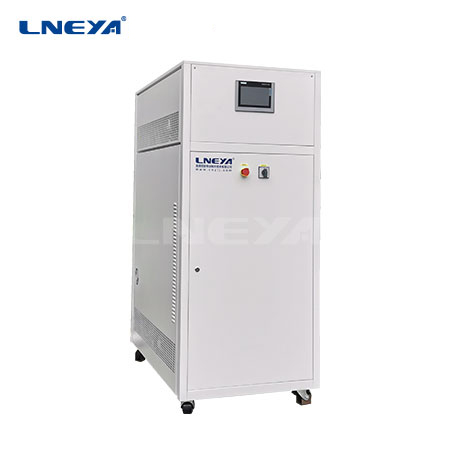Circulating Cooling Water System
Kontaktieren Sie uns noch heute für die perfekte Lösung zur Temperaturkontrolle
The circulating cooling water system is configured for water cooling of production equipment. A cooling water system that uses water as the cooling medium and circulates it. After the cold water flows through the production equipment that needs to be cooled (often called heat exchange equipment, such as heat exchangers, condensers, and reactors), the temperature rises. If it is discharged immediately, the cold water is only used once (called a once-through cooling water system). When the heated cold water flows through the cooling equipment, the water temperature will drop back, and it can be pumped back to the production equipment for reuse. The consumption of cold water is greatly reduced, and more than 95% can often be saved. Cooling water accounts for about 70% of industrial water consumption. Therefore, the circulating cooling water system plays a role in saving a large amount of industrial water.

Cooling equipment can be divided into open and closed types, so circulating cooling water systems are also divided into open and closed types.
Open systems are more complex to design and operate. There are two types of open cooling equipment: cooling pools and cooling towers, both of which mainly rely on the evaporation of water to reduce water temperature. Furthermore, cooling towers often use fans to promote evaporation, and the cooling water is often blown away. Therefore, the open circulating cooling water system must be supplied with fresh water. Due to evaporation, the circulating water is concentrated, and the concentration process will promote salt scaling. Supplementary water has a dilution effect, and its flow rate is often determined based on the concentration limit of circulating water. Usually the amount of supplementary water exceeds the amount of water lost by evaporation and wind blowing, so some circulating water (sewage) must be discharged to maintain the balance of water volume.
In an open system, due to the contact between water flow and the atmosphere, dust, microorganisms, etc. enter the circulating water; in addition, the escape of carbon dioxide and the leakage of materials in the heat exchange equipment also change the quality of the circulating water. For this reason, circulating cooling water often needs to be treated, including sediment control, corrosion control and microbial control. The determination of the treatment method is often related to the quantity and quality of the make-up water, as well as the performance of the production equipment. When using multiple agents, possible chemical reactions between agents should be avoided.
Closed circulating cooling water system uses closed cooling equipment, and the circulating water flows in the tube and usually uses wind to dissipate heat outside the tube. Except for material leakage from heat exchange equipment, there are no other factors that change the quality of circulating water. To prevent salt scaling in heat exchange equipment, cooling water sometimes needs to be softened. In order to prevent heat exchange equipment from being corroded, corrosion inhibitors are often added: Pay attention to safety when using high-concentration, highly toxic corrosion inhibitors, and the cooling water discharged during maintenance should be properly disposed of.
E-Mail: info@lneya.com WeChat ID: +8615251628237 WhatsApp: +86 17851209193
 Präzisionskältemaschinen / Kleinkältemaschinen
Präzisionskältemaschinen / Kleinkältemaschinen
Die Kältemaschine kann in verschiedenen Industrien und Labors eingesetzt werden und unterstützt kundenspezifische Designs.
| Temperaturbereich | -18°C ~ +30°C | +5°C ~ +35°C Reihe |
| Kühlleistung | 0,35 ~ 0,9kW | 1,8 ~ 50kW |

Rückkühler
Unser Rückkühler arbeitet mit Niedertemperatur-Kältetechnik, die Temperatur beträgt bis zu -120℃, und verschiedene Zubehörteile sind anpassbar.
| Temperaturbereich | Serie -25°C ~ +30°C | -45°C ~ +30°C Reihe | Serie -60°C ~ -20°C | Serie -80°C ~ -20°C | Serie -120°C ~ -70°C |
| Kühlleistung | 0,8 ~ 30kW | 0,75 ~ 12kW | 0,4 ~ 6kW | 0,2 ~ 6kW | 0,3 ~ 5kW |

Niedertemperatur-Kühlgeräte
Wir haben uns auf die Herstellung von Niedertemperaturkältemaschinen mit einem Temperaturregelbereich von bis zu -150°C spezialisiert, die den Kühlbedarf verschiedener Branchen decken.
| Temperaturbereich | Serie -25°C ~ -5°C | Serie -45°C ~ -10°C | Serie -60°C ~ -10°C | Serie -80°C ~ -30°C | Serie -110°C ~ -50°C | Serie -150°C ~ -110°C |
| Kühlleistung | 12 ~ 360kW | 6 ~ 180kW | 6 ~ 180kW | 4 ~ 180kW | 2 ~ 120kW | 2,5 ~ 11kW |
Temperatursimulation für die Qualitätsprüfung von Fahrzeugen: Prüfung der Batterielebensdauer, Prüfstand für Einspritzdüsen/Motoren, Airbag-Prüfung, Komponentenprüfstand, usw.

Geeignet für die präzise Temperaturkontrolle von elektronischen Bauteilen. Bei der Herstellung von elektronischen Halbleiterkomponenten für raue Umgebungen umfassen die Phasen der IC-Gehäusemontage sowie der Entwicklungs- und Produktionstests auch elektronische Wärmetests und andere Simulationen von Umwelttests.

Flüssigkeitskühlung für Batterie-Energiespeichersysteme
| Typen | Für Converting Station | Für Energiespeicherbatterie | Für die Ladestation |
| Kühlleistung | 45kW | 5 ~ 8,5kW | 4kW |

Baureihe ZLFQ
Kühlmittelverteilereinheit
Flüssigkeitskühlgeräte eignen sich für die Prüfung von Halbleitern, die Prüfung elektronischer Geräte bei konstanter Temperatur, die Kühlung der Serverinfrastruktur und andere Orte, an denen die Temperatur von Flüssigkeiten kontrolliert wird.
| Temperaturbereich | +5°C ~ +35°C | +5°C ~ +35°C |
| Kühlleistung | 15 ~ 150kW | 200 ~ 500kW |

MD-Thermofutter-Serie
Es wird für die Prüfung von HF-Bauteilen und Leistungsbauteilen mit hoher Dichte (IGBTs und MOSFETs) verwendet und kann auch für die schnelle Kühlung von flachen Laborplatten (Plasma, biologische Produkte, Batterien) usw. eingesetzt werden.
| Temperaturbereich | -75°C ~ +225°C |
| Temperaturgenauigkeit | ±0.1℃ |

Schraubenkühler (Benutzerdefinierte Designs)
Niedertemperatur-Schraubenkühlmaschinen und Raumtemperatur-Schraubenkühlmaschinen
| Temperaturbereich | +5°C ~ +30°C | +5°C ~ +30°C | +5°C ~ +30°C | +5°C ~ +30°C | -25°C ~ +5°C | -25°C ~ +5°C |
| Kühlleistung | 107 ~ 1027kW (Einzelverdichter) | 299 ~ 2134kW (Doppelkompressor) | 98 ~ 934kW (Einzelverdichter) | 272 ~ 1940kW (Doppelkompressor) | 48 ~ 467kW (Einzelverdichter) | 51 ~ 497kW (Einzelverdichter) |
 LNEYA
LNEYA
 简体中文
简体中文



















































































